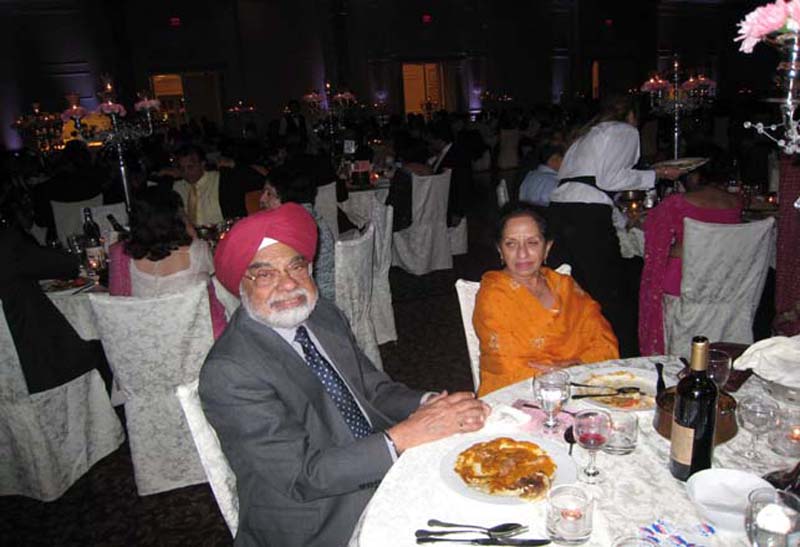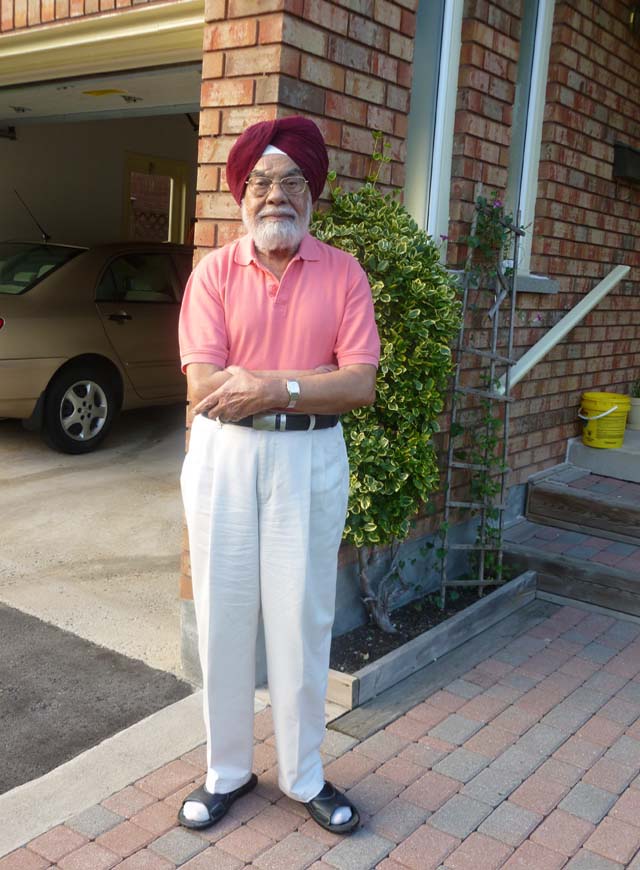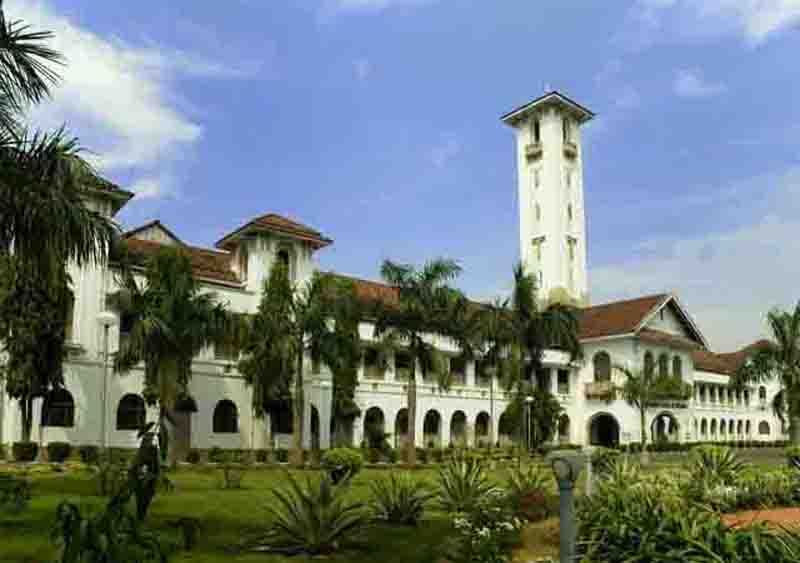Web Desk
TORONTO: When the global IIT alumni meeting in Kolkata in December honours their senior-most and first-batch colleagues to pass out from the Indian Institute of Technology at Kharagpur in 1955, Canada’s oldest IITian Jogendra Singh could be one of them.
'Yes, I have been invited to the three-day PanIIT Global Conference in Kolkata from December 7, but I have yet to make up my mind,’’ says 80-year-old Singh who lives in Mississauga.
And soon his conversation turns to how the Indian Institutes of Technology (IITs) have become India's top global brand today - 60 years later.
'Yes, the seeds of the IIT brand were sown with our first batch (1951-55). We were 210 selected from all over the country through a rigorous process to study at India's first IIT at Kharagpur. We were constantly reminded that we were the cream of India and supposed to excel,’’ says Singh.
'On the very first day, we were told that no mercy will be shown to us, and no mercy was shown. That’s how IIT standards were set.’’
But he gives most of the credit for today’s IIT brand to the first prime minister Jawaharlal Nehru for his deep interest in tech education.
"The IITs were part of Nehru’s vision for India’s industrial development. He took personal interest in the first IIT and got the then West Bengal chief minister Bidhan Chandra Roy to give land for it at Kharagpur,’’ Singh says.
[caption id="attachment_79545" align="alignnone" width="800"] IITian Jogendra Singh (seen here with his wife at a party) says, “We were constantly reminded that we were the cream of India and supposed to excel.”[/caption]
He recalls Nehru coming down for the foundation ceremony of the IIT building. "The prime minister again came for our convocation ceremony and spoke eloquently. We all shook his hands. Nehru was an intellectual giant but very emotional. On the contrary, education minister Abul Kalam Azad was a very calm person. He was very fatherly.’’
Giving examples of how touchy and sensitive Nehru was about properly nurturing the first IIT and its students, Singh recalls, "Once we were planning to go on a hunger-strike to protest against the mess contractor for giving us the same food every day. I think it used to be aloo-poori for breakfast, lunch and dinner. We told the Statesman correspondent in Kharagpur that we are going to go on a hunger-strike to protest against the mess contractor.
"The news was published and Nehru came to know of our hunger-strike. He was angry and phoned IIT director Dr J.C. Ghosh and showed his displeasure. Dr Ghosh called Dr B.R. Seth - who was president of the Gymkhana (students’ body) as well as head of the math department - to look into the matter immediately. Nehru must have scolded him. So Dr Seth came to us to tell that the contractor was being changed. On our suggestion, he also created four sections in the mess - north India, south India, east India and general mess - to cater to students from all regions of India.
[caption id="attachment_79540" align="alignnone" width="640"]
IITian Jogendra Singh (seen here with his wife at a party) says, “We were constantly reminded that we were the cream of India and supposed to excel.”[/caption]
He recalls Nehru coming down for the foundation ceremony of the IIT building. "The prime minister again came for our convocation ceremony and spoke eloquently. We all shook his hands. Nehru was an intellectual giant but very emotional. On the contrary, education minister Abul Kalam Azad was a very calm person. He was very fatherly.’’
Giving examples of how touchy and sensitive Nehru was about properly nurturing the first IIT and its students, Singh recalls, "Once we were planning to go on a hunger-strike to protest against the mess contractor for giving us the same food every day. I think it used to be aloo-poori for breakfast, lunch and dinner. We told the Statesman correspondent in Kharagpur that we are going to go on a hunger-strike to protest against the mess contractor.
"The news was published and Nehru came to know of our hunger-strike. He was angry and phoned IIT director Dr J.C. Ghosh and showed his displeasure. Dr Ghosh called Dr B.R. Seth - who was president of the Gymkhana (students’ body) as well as head of the math department - to look into the matter immediately. Nehru must have scolded him. So Dr Seth came to us to tell that the contractor was being changed. On our suggestion, he also created four sections in the mess - north India, south India, east India and general mess - to cater to students from all regions of India.
[caption id="attachment_79540" align="alignnone" width="640"] IITian Jogendra Singh recalls how Prime Minister Jawaharlal Nehru became furious after he came to know of their hunger-strike over food in the mess and phoned the IIT Kharagpur director to address their grievances immediately.[/caption]
"But when Nehru came to know of these north/south/east/west sections in our mess, he again got furious. Probably the reason for his outburst was the new agitation for linguistic states. So he told the mess director to stop this north-south thing and have only two sections: veg and non-veg. That showed how particular Nehru was about engendering the right culture at the IITs.’’
Singh says he had just completed his B.Sc (honours) in physics from Delhi’s St. Stephen's College in 1951 when an advertisement for IIT admissions appeared in the newspapers.
"Interviews were held in Delhi, Bombay, Calcutta, Madras and Allahabad. I remember 10 students were selected from each state. There were 60 seats each for mechanical, civil and electrical engineering. Plus there were 30 seats for building construction which were later merged with civil engineering.’’
Were there any girls among them? "Oh, no. Not even when I graduated in 1955,’’ laughs Singh.
As there were not many Indian teachers at the time, he says, mostly foreigners headed the IIT departments. "Since IIT Kharagpur was financed by UNESCO, foreign professors came there as part of that. One Dr Kraus was head of mechanical engineering. He was from Germany.''
[caption id="attachment_79542" align="alignnone" width="800"]
IITian Jogendra Singh recalls how Prime Minister Jawaharlal Nehru became furious after he came to know of their hunger-strike over food in the mess and phoned the IIT Kharagpur director to address their grievances immediately.[/caption]
"But when Nehru came to know of these north/south/east/west sections in our mess, he again got furious. Probably the reason for his outburst was the new agitation for linguistic states. So he told the mess director to stop this north-south thing and have only two sections: veg and non-veg. That showed how particular Nehru was about engendering the right culture at the IITs.’’
Singh says he had just completed his B.Sc (honours) in physics from Delhi’s St. Stephen's College in 1951 when an advertisement for IIT admissions appeared in the newspapers.
"Interviews were held in Delhi, Bombay, Calcutta, Madras and Allahabad. I remember 10 students were selected from each state. There were 60 seats each for mechanical, civil and electrical engineering. Plus there were 30 seats for building construction which were later merged with civil engineering.’’
Were there any girls among them? "Oh, no. Not even when I graduated in 1955,’’ laughs Singh.
As there were not many Indian teachers at the time, he says, mostly foreigners headed the IIT departments. "Since IIT Kharagpur was financed by UNESCO, foreign professors came there as part of that. One Dr Kraus was head of mechanical engineering. He was from Germany.''
[caption id="attachment_79542" align="alignnone" width="800"] Since the Kharagpur IIT building was not ready in 1951, India's first IIT batch started at the Hijli Jail where the British used to keep political prisoners. The jail was lying vacant after India's independence in 1947 and thus was put to good use.[/caption]
Since the IIT Kharagpur building was not ready in 1951, the classes for the first batch started in the old jail in the small village of Hijli.
"It was a huge political prison which was lying vacant after India’s independence. West Bengal chief minister Bidhan Chandra Roy gave it to the IIT. Slowly, the new campus started coming up,'' says Singh.
He says his monthly mess bill used to come to Rs 60. "That was a bit high. But our annual fee was Rs 200, and we used to pay it in four installments.’’
Since Kharagpur was a railway town, he says, there were no recreational facilities there in those days. "But there used to be an Anglo-Indian club called the South Institute where they often showed English movies. We used to go there once in a while. That was the only luxury to us in those days,’’ he recalls.
After earning his electrical engineering degree in 1955, Jogendra Singh served in various capacities - first with the Central Water and Power Commission (CWPC) and then the Delhi Electric Supply Undertaking (DESU) where he was one of the two superintending engineers (distribution). In 1975, he decided to emigrate to Canada.
Since his 20-year work experience and IIT degrees had no recognition in Canada, Singh had to do his M.Sc from the University of Saskatchewan to be eligible for a job.
He joined Ontario Hydro after earning his Canadian degree and retired in 1997.
Winding off the conversation, he laughs, "You know, I changed the spellings of my name from Joginder to Jogendra as I was impressed by Sir Jogendra Singh, who was on the viceroy’s executive council and the brain behind the IITs, after meeting him during a visit to our school in Ajmer in the mid-1940s. I never knew at the time that I will be the first product (IITian) of his idea.’’
READ ALSO: Bal Krishan Kaplish was first IITian to abroad and marry a foreigner
Since the Kharagpur IIT building was not ready in 1951, India's first IIT batch started at the Hijli Jail where the British used to keep political prisoners. The jail was lying vacant after India's independence in 1947 and thus was put to good use.[/caption]
Since the IIT Kharagpur building was not ready in 1951, the classes for the first batch started in the old jail in the small village of Hijli.
"It was a huge political prison which was lying vacant after India’s independence. West Bengal chief minister Bidhan Chandra Roy gave it to the IIT. Slowly, the new campus started coming up,'' says Singh.
He says his monthly mess bill used to come to Rs 60. "That was a bit high. But our annual fee was Rs 200, and we used to pay it in four installments.’’
Since Kharagpur was a railway town, he says, there were no recreational facilities there in those days. "But there used to be an Anglo-Indian club called the South Institute where they often showed English movies. We used to go there once in a while. That was the only luxury to us in those days,’’ he recalls.
After earning his electrical engineering degree in 1955, Jogendra Singh served in various capacities - first with the Central Water and Power Commission (CWPC) and then the Delhi Electric Supply Undertaking (DESU) where he was one of the two superintending engineers (distribution). In 1975, he decided to emigrate to Canada.
Since his 20-year work experience and IIT degrees had no recognition in Canada, Singh had to do his M.Sc from the University of Saskatchewan to be eligible for a job.
He joined Ontario Hydro after earning his Canadian degree and retired in 1997.
Winding off the conversation, he laughs, "You know, I changed the spellings of my name from Joginder to Jogendra as I was impressed by Sir Jogendra Singh, who was on the viceroy’s executive council and the brain behind the IITs, after meeting him during a visit to our school in Ajmer in the mid-1940s. I never knew at the time that I will be the first product (IITian) of his idea.’’
READ ALSO: Bal Krishan Kaplish was first IITian to abroad and marry a foreigner